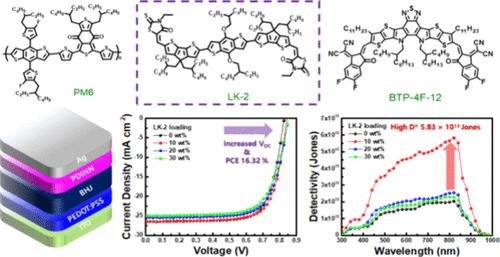Achieving Balanced Energy Harvesting and Light Detection via Compositional Modulation with a High-LUMO-Level Nonfused-Ring Electron Acceptor
IF 6.5
1区 物理与天体物理
Q1 MATERIALS SCIENCE, MULTIDISCIPLINARY
引用次数: 0
Abstract
Organic photovoltaics (OPVs) and organic photodetectors (OPDs) offer promising energy harvesting and photodetection capabilities. In this study, we newly designed and synthesized a novel nonfused-ring electron acceptor (NFREA) named “LK-2” with a high lowest unoccupied molecular orbital (LUMO) level of −3.61 eV. We aimed to enhance the energy harvesting performance in OPVs by improving the open-circuit voltage (VOC) and light detecting ability by mitigating the dark currents in the OPDs. LK-2 was incorporated into the host photoactive material comprising PM6 donors and BTP-4F-12 acceptors using a ternary strategy that facilitated compositional modulation among the materials. The inclusion of LK-2 resulted in an improved VOC of 0.84 V under 1-sun illumination and a significantly suppressed dark current density of 2.77 × 10–10 A cm–2 under a self-powered condition. The effective intermixing of LK-2 with PM6 and BTP-4F-12 facilitated a favorable thin-film morphology, contributing to enhanced device performance. Furthermore, LK-2 suppressed bimolecular recombination under low light intensities and reduced noise currents, resulting in a broad linear dynamic range even under reverse bias conditions. This study highlighted the potential of the newly developed NFREA for simultaneously enhancing the performance of both OPV and OPD devices, offering a balanced approach to realize energy harvesting and light detection.

通过高 LUMO 级非熔环电子受体的成分调制实现平衡的能量收集和光探测功能
有机光伏(OPV)和有机光电探测器(OPD)具有前景广阔的能量收集和光电探测功能。在这项研究中,我们新设计并合成了一种名为 "LK-2 "的新型非熔环电子受体(NFREA),其最低未占分子轨道(LUMO)电平高达 -3.61 eV。我们的目标是通过减轻 OPD 中的暗电流来提高 OPV 的开路电压(VOC)和光探测能力,从而增强 OPV 的能量收集性能。采用三元策略将 LK-2 加入由 PM6 给体和 BTP-4F-12 受体组成的主光活性材料中,从而促进了材料之间的成分调制。加入 LK-2 后,在 1 太阳光照射下的 VOC 提高到 0.84 V,而在自供电条件下的暗电流密度则显著降低到 2.77 × 10-10 A cm-2。LK-2 与 PM6 和 BTP-4F-12 的有效混合有助于形成良好的薄膜形态,从而提高器件性能。此外,LK-2 还能抑制低光强下的双分子重组,降低噪声电流,从而即使在反向偏压条件下也能获得宽广的线性动态范围。这项研究强调了新开发的 NFREA 在同时提高 OPV 和 OPD 器件性能方面的潜力,为实现能量收集和光检测提供了一种平衡的方法。
本文章由计算机程序翻译,如有差异,请以英文原文为准。
求助全文
约1分钟内获得全文
求助全文
来源期刊

ACS Photonics
NANOSCIENCE & NANOTECHNOLOGY-MATERIALS SCIENCE, MULTIDISCIPLINARY
CiteScore
11.90
自引率
5.70%
发文量
438
审稿时长
2.3 months
期刊介绍:
Published as soon as accepted and summarized in monthly issues, ACS Photonics will publish Research Articles, Letters, Perspectives, and Reviews, to encompass the full scope of published research in this field.
 求助内容:
求助内容: 应助结果提醒方式:
应助结果提醒方式:


